Weekend Getaways: Gananoque & the Thousand Islands
The Great Inland Archipelago
© By John Arkelian
© Photography by Ian Coristine
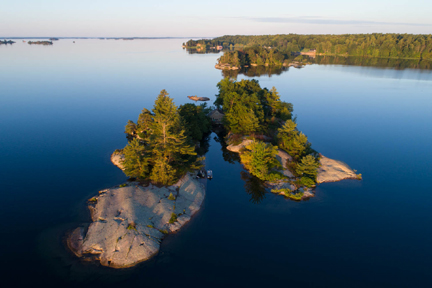
Copyright © 2018 by Ian Coristine (1000IslandsPhotoArt.com)
Sometimes another world, like a secret garden, lies close at hand but utterly unsuspected. So it is with our continent’s Great Inland Archipelago. A mere two-and-a-half hours drive from the eastern marches of the Greater Toronto Area, it may as well be worlds away. For this is a world all its own, where water and land meet in infinite combinations amidst a freshwater river, the mighty St. Lawrence, that’s more akin to a broad inlet of the sea than it is to a conventional river. This is the new world, after all, and nature makes her presence felt here in grand, impressive ways. Over 1800 islands, large and small, comprise what’s known as the Thousand Islands. And the gateway to their serene beauty is the small town of Gananoque on Canada’s mainland shore. The place may be

Copyright © 2018 by Ian Coristine (1000IslandsPhotoArt.com)
permanent home to only 5,200 souls, but a pleasanter town cannot be imagined – it’s full of history, character, and beauty.
My base for my weekend visit is the better than serviceable (and perfectly situated) Comfort Inn & Suites on Main Street. The proud stone homes that surround it lend it an air of elegance by association: Indeed, the neighborhood feels residential, with gardens and hedges and trees that are shyly trying on their early fall finery. But it is situated on the very edge of the town’s irresistible commercial street. King Street is a main street that even much bigger burghs could envy. The Gananoque River on its west side broadens into a town lake which reflects the glowering clouds in its blue face. And King Street is a queue of one heritage building after
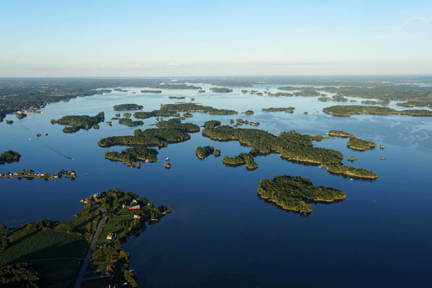
Copyright © 2018 by Ian Coristine (1000IslandsPhotoArt.com)
another – a micro-brewery here, a stately town hall there. A mermaid-like painting on an exterior stone wall confides that, “There is no exquisite beauty without some strangeness in [the] proportion.” So saith Edgar Allen Poe, but we discern no ‘strangeness’ in these proportions, only a most pleasing convergence of artfulness and history.
I concentrate my attention on art galleries, making my first stop at the Heather Haynes Gallery. Fortuitously, it’s the opening show for two artists; but it may be that, as gallery owners (and spouses) Heather Haynes and Jeff Montgomery suggest, “There are no coincidences.” The artists are present – Michelle Reid’s paintings with riotous fall colors catch my eye, as does Suzy Lamont’s
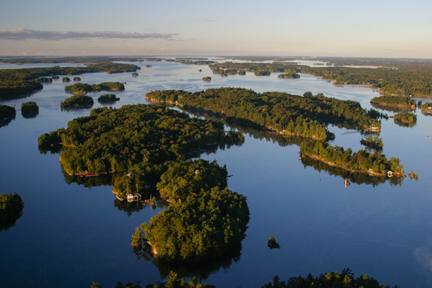
Copyright © 2018 by Ian Coristine (1000IslandsPhotoArt.com)
photography. There are some of Haynes’ own paintings of orphaned girls in the Congo – profiles of courage among the dispossessed. There are charcoal drawings by Laurie Sponagle that look a lot like B&W photographs, with a long seascape capturing my interest. And there is one of the most arresting pieces on show. “The Offer,” by Montgomery’s artist father, has two figures (a male and a female) on a wintry white background; with their backs to us, the human figures seem at once small in the grasp of nature and also fortified by their simple companionship: they face what comes together, and that gives them strength. All that can be gleaned from the painting; its back-story gives it added poignancy. When Peter Montgomery lost his beloved wife, he painted over his partially finished picture of
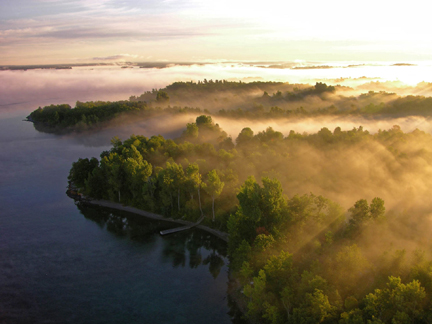
Copyright © 2018 by Ian Coristine (1000IslandsPhotoArt.com)
her in a kayak, producing something that gives the ineffable sense of them as a couple on a life journey, even though it is not necessarily intended to be a literal portrait of the pair.
Next up is Arts & Craft Collective, which is home to an eclectic mix of arts, crafts, and classes. Tikvah Mindorff, a recent émigré from St. Catharines, handles the business end of things, while her colleague, Calvin Chumbley is the resident artist. The building is one of the town’s oldest (dating from the 1890s); once a Catholic Church, it later served as a doctor’s office. The pottery-makers’ studio, complete with wheel and kiln, are in the former medical observation room, which still has its original clay tile floors. There are workshops for making Venetian-style masks (for an upcoming town
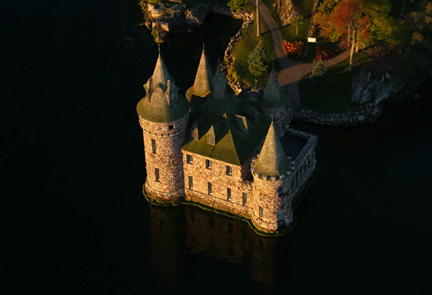
Copyright © 2018 by Ian Coristine (1000IslandsPhotoArt.com)
masquerade ball), second-hand vintage clothing (“all very hipster,” confides Tikvah), plans for a print-making shop with silk-screening, and an upcoming contemporary art show which will emphasize “really cool, tactile, sensory simulation.” Speaking of which, as an admirer of the fair sex, I can’t help but notice a fetching size two black mini-dress with mother of pearl buttons.
Across the street, I chat with Dennis O’Conner at the O’Connor Gallery. A longtime gallery owner in Toronto, he’s moved to this little piece of paradise and thrown his hat into the municipal election ring, as a candidate for town council (he was, incidentally, successful in his electoral bid after my visit). He shows abstract art and Inuit art; and he epitomizes living his artistic calling, by also doing interior
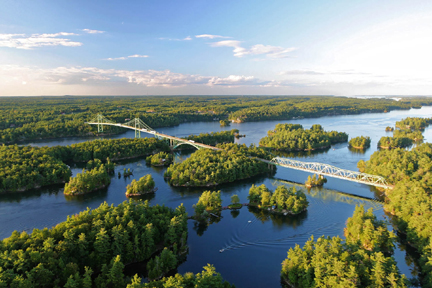
Copyright © 2018 by Ian Coristine (1000IslandsPhotoArt.com)
design, custom furniture, and draperies. There’s an exhibition of fanciful handmade mandolins; and, the gallery has its own credo: “I have far too much respect for art to reduce it to decoration.” O’Connor says “You have to teach people about art… It’s not taught in schools anymore.” He’s clearly got the energy, enthusiasm, and creative vision to get the job done. I traverse some steep stairs with two of his personable artists to visit their top-floor living space and studio – an inviting space with high brick walls and oversized abstract art in various stages of completion. Steve Behal and Jeannie Catchpole migrated here from the United States. One of their large pieces conjured a Rorschach effect: I’m convinced I see a two-dimensional variation on Rodin’s sculpture “The Thinker,”
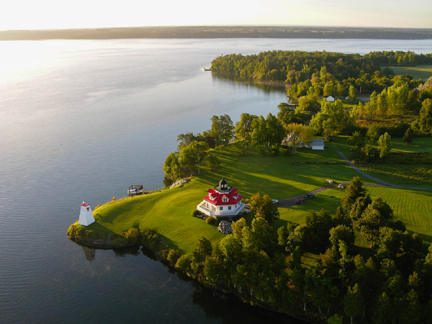
Copyright © 2018 by Ian Coristine (1000IslandsPhotoArt.com)
though it seems no such allusion was intended by the artists, who, it must be added, share a winning sense of humor along with their artistic verve.
As I depart the studio, I compare impressions with Lorraine Payette, who reports for the local newspaper. And I take a moment to reconnoiter the nearby Beggars Banquet Bookstore, which does double duty as home to Dragon Records. Bibliophiles and lovers of LPs beware!
One more treat awaits me on King Street. I sup with a good friend at Riva Italian Restaurant, which is right next to my lodgings, where King meets Main. I love the elegant building and grounds (even the washroom is as sleek and modern as can be), and the place

Copyright © 2018 by Ian Coristine (1000IslandsPhotoArt.com)
is doing a booming business even in this quieter season of fall. We start with pane rustico, the house baked bread which reminds me of the colloquial expression of approval, “just like mother used to make.” My salad course (insalata alla riva) is a pleasing combination of baby spinach, arugala, almonds, delectable house-pickled peppers, and an orange and basil dressing, though had I noticed the plentiful presence of olives in advance, I might have made a different selection. For a main, I choose ravioli di funghi, which combines pasta stuffed with mushrooms and mascarpone with a house-made ground sausage and tomato sauce; it’s top-notch. I wash it down with apple juice that pleasingly looks and tastes more like cider, like it came directly from crushed apples, liquefied pulp
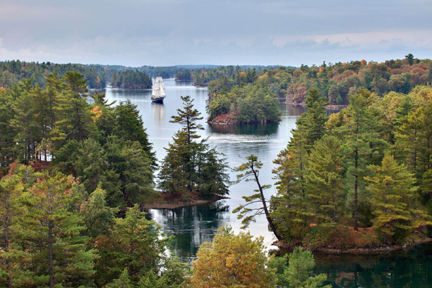
Copyright © 2018 by Ian Coristine (1000IslandsPhotoArt.com)
and all. And we finish with a perfect chocolaty mousse.
There’s just enough time to catch my breath (and rest my full tummy) at the Inn and chat with the Innkeeper on duty: An expatriate from Kent, England, Roger doesn’t let the fact that it is mid-October stop him from swimming in the not exactly balmy St Lawrence. Then, I’m off, by foot, since it’s a mere 12-minute walk, to the Thousand Islands Playhouse for a first-rate production of the Willy Russell play “Shirley Valentine.” It’s a brilliant one-woman show, starring Toronto-based actress Deborah Drakeford, and it’s nothing short of a tour de force. How can it be that Broadway-caliber theatrics are happening in this small place? From her dreary and dull domestic life in Liverpool to her

Copyright © 2018 by Ian Coristine (1000IslandsPhotoArt.com)
reawakening on the Greek coast, Drakeford immerses us in her character’s perspicacity, yearning, and wit. It’s a sheer pleasure to spend time with this character; she’s at once colorful and fully authentic. Kudos to Andrew Kushnir, who directed the play, and to Jung-Hye Kim who did stand-out work with the sets and costumes: the former – an English kitchen and a seaside patio in Greece are right on the money, perfect in every detail. Under Managing Artistic Director Brett Christopher, the Playhouse (which sits directly on the river’s shore and has two auditoriums) has a full season of live theater and music every year from late-May till mid-October. It’s a gem. Even if this town (and region) had nothing else going for them – which is wildly far from being so – the Playhouse alone would

Copyright © 2018 by Ian Coristine (1000IslandsPhotoArt.com)
make this place a must-visit destination for theater-lovers from the GTA and beyond.
It’s as cold as winter in the wee hours of Saturday night (as I discover on an excursion to the parking lot to retrieve a coat from the car), but Sunday morning proper brings a
perfect fall day – sunny and comfortably cool. There’s a quick bite to eat in the Inn’s lobby, then a five minute walk down the street to the harbor, where my friend and I line-up for a five hour cruise with the Gananoque Boat Line. In the queue, we chat with Bob and Marilyn, an instantly likeable couple from Texas who are visiting parts of southern Ontario and Quebec for the first time. (I suggest some additional destinations in Canada and humorously suggest that
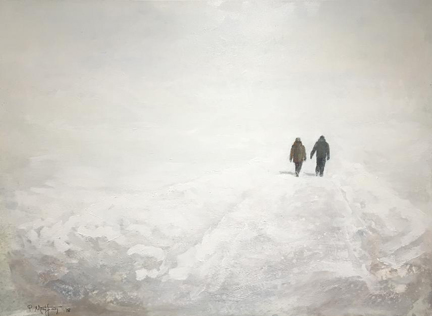
“The Offer” © 2018 by Peter Montgomery (acrylic on canvas) – courtesy of Heather Haynes Gallery
they give their northern neighbor’s winter a try sometime.) On board, I admire the ability of a younger man (traveling from some unknown foreign parts with his wife and kids) to adroitly pull off the wearing of a fedora. It’s an ideal time of year for the cruise. There are plenty of empty seats to choose from and a smaller crowd (and sparsity of children) makes for a quieter day on the water. The Thousand Islands are pleasure to behold. They come in all sizes; with occupants who range (one assumes) from the comfortably off to millionaires. The on-board narration describes the islands, the currents, the pirates, shipwrecks, and towering international bridge that connects the world’s two closest national siblings – Canada and the United States. We disembark at Heart Island, on the U.S. side of the border, for a two-hour excursion into the romantic imagination at Boldt Castle. It’s the testament to a man’s love for his wife, though she tragically died before she ever saw it. I’m ready to take up permanent residence. Roaming its grand rooms, its verandas and balconies, and its tree-lined shore is the stuff dreams are made on. On the return trip, we pass though one of my favorite sections, a narrow strait in which both shores (and the homes they support) are clearly visible: I feel as though I’m passing through a navigable residential area and getting a close-up feel for life here on the banks of the river. For some reason, it makes me think of the inhabitants of “The Wind in the Willows.”
The end of the cruise means the end of my visit, alas. I’m sorry to leave. Gananoque and the Thousand Islands may make the perfect weekend getaway; but they left me longing for an even longer stay.
******************
John Arkelian is an award-winning author and journalist. Among his eclectic pursuits, he has represented Canada abroad as a diplomat, advised the federal cabinet as an international lawyer, conducted criminal prosecutions as a federal Crown attorney, served as a professor of media law, been a candidate for Parliament, and directed an international film festival. He is the founding editor of Artsforum Magazine.
Ian Coristine is the preeminent photographic interpreter of the Thousand Islands. A former distributor for ultra-light aircraft, his love affair with the Islands began during a random flight in 1992. His several best-selling books of photography about the region have sold over 119,000 copies; his images have been featured in magazines around the world as well as in many other books, including Parks Canada’s 125th anniversary tribute, “Canada’s National Parks: A Celebration;” and his work has been shown in several one-man exhibitions. ‘DxO Labs’ of Paris, award-winning publishers of camera and lens correction software, selected Coristine as one of their founding “Image Masters.” The city of Brockville has recognized him for the attention his work has brought the region. For more examples of Ian Coristine’s beautiful work, visit: http://www.1000islandsphotoart.com
Copyright © 2018 by John Arkelian
Photographs © 2018 by Ian Coristine (unless otherwise noted)
Editor’s Note: See our capsule review of Ian Coristine’s first book, “The 1000 Islands,” at: https://artsforum.ca/books/books-in-brief
***************************************
A Venice Diary
© By Cathy Griffin
© Photography by Jonathan van Bilsen
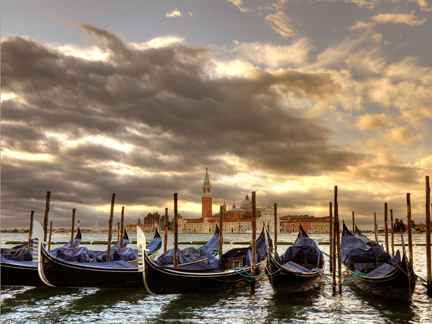
Venetian Dawn — Copyright © 2018 by Jonathan van Bilsen
I awake early with one purpose in mind – to see the sunrise over Venice as we sail into her harbour. A week ago, I stood on the deck in the dusk with the light blurring across this ancient city’s silhouette as we set sail for the Greek islands. Now, returning, I gaze across the water as the sun rises over the Doge’s Palace, St. Marks Basilica, and the Grand Canal; the Salute Church at the city’s entrance is a beacon that draws me in.
Venice is a feast for the eyes with ten centuries of spectacular architecture – churches, canals, bridges, and palaces – lined up along the water. There is such freedom from the sound of traffic. The buildings seem to rise and sink with the tide: it is a city sprung from the sea and living in it. Church bells ring all day long. At noon, all
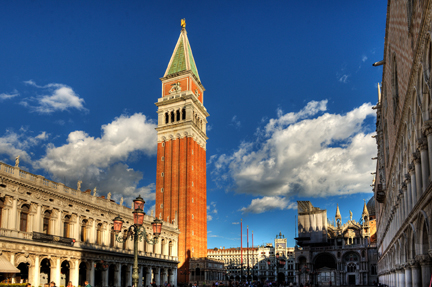
Bell Tower in St Mark’s Square — Copyright © 2018 by Jonathan van Bilsen
the bells in the city ring out at once in chorus.
A water bus, Vaporetto #51, takes me to the Castello district and my home for the next week. Away from the crowds of tourists, it’s where the Venetians live their day to day lives – there’s laundry hanging across the alleys, people walking their dogs along the canals, boats passing, children playing, outdoor restaurants and bars, and, of course, streets with no cars, just the sound of my feet on the stones. I walk along the water towards St. Mark’s Square. From a distance, I see a swarm of tourists near the Bridge of Sighs, so I decide to save it for another morning, retreating instead to the serenity of San Pietro Island and the Church of San Pietro.
The most unforgettable experiences happen when you least suspect
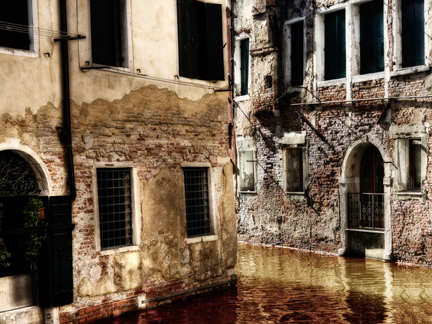
Venetian Canal — Copyright © 2018 by Jonathan van Bilsen
them One morning, as soon as I step out to the canal at the end of my street, the water is up to the buildings. A fisherman in his boat motions for me to go down the next street. The closer I approach St. Mark’s Square, the higher the water level rises. Tourists are coming out of their hotels wheeling their luggage on ramps. The Ducale Palace has water up to its foundation, and people are walking on raised boardwalks along the front of St. Mark’s Basilica. The entire square is covered in eighteen inches of water. Young men roll up their pants and remove their shoes to walk across. A few wear green rubber boots above their knees and others have plastic bags tied above the knees, sold by enterprising vendors. I wander through a maze of alleys behind St. Mark’s searching for a dry way

Island and Church of San Giorgio Maggiore, Venice — Copyright © 2018 by Jonathan van Bilsen
back. Overhearing some American tourists, I follow their guide for a third attempt back to the waterfront. I will always remember my day of acqua alta, or high water.
The Palazzo du Leoni began in the 1700’s but was left unfinished, with only the ground floor built. Peggy Guggenheim bought it after the Second World War and spruced it up. It was the place to be in the 50’s and 60’s, when the Biennale brought in actors, artists, writers, and composers. Guggenheim’s drawing room became an important center of the international art world, promoting such artists as Picasso, Alexander Calder, Jackson Pollock (also known as ‘Jack the Dripper’), Chagall, and Dali. She entertained the likes of Paul Newman, Marlon Brando, John Lennon, and Yoko Ono.
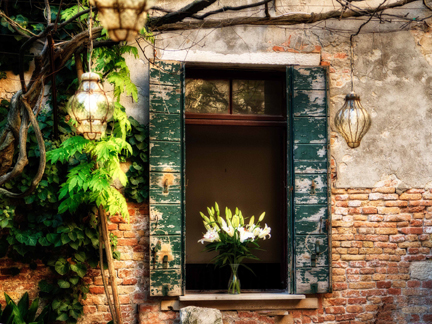
Window on Venice — Copyright © 2018 by Jonathan van Bilsen
Overlooking the Grand Canal, her terrace displays provocative sculptures for the passing water traffic. Black & white pictures of Guggenheim amongst her artwork, and of her Lhasa Apsos, are displayed throughout her home. Her grave, next to her cherished dogs’ resting place, lies in a corner of the Sculpture Garden, with two plaques: “Here lie my Beloved Babies” alongside “Here Rests Peggy Guggenheim 1898 – 1979”. The Venetians called her the “Last Dogaressa.” There’s an olive tree, a gift from her travelling friend Yoko Ono, with two wish messages left in the basket; I fill one out and place it in the tree.
In search of Titian’s altarpiece “The Assumption of the Virgin,” I enter the Frari church. Looking down the nave, Titian’s masterpiece
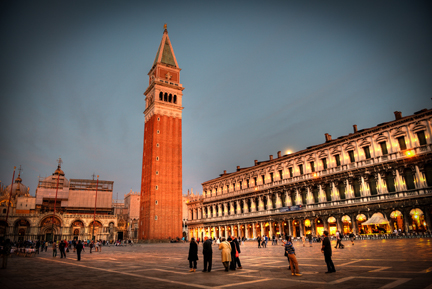
The Bell Tower in St Mark’s Square, Venice — Copyright © 2018 by Jonathan van Bilsen
is framed by the arch of the choir entrance: glowing red and gold, it lights up like a stained glass window. Surrounded by chapels and tombs (including that of Titian himself), it feels as though mortals are mingling with saints. The Assumption has three levels: God in heaven, man on earth, and Mary in-between. Her face radiates as she ascends into heaven.
The interior of St. Mark’s Basilica is dark, despite all the gold. I notice that part of the floor is covered in water. Islamic influence is strongly felt here. I walk through a football field of gold mosaics. The rood screen separates the Golden Altarpiece from the public. A huge crucifix hangs in the central dome. On either side of the altar screen is the Doge’s Pulpit. To the left of the altar is the Nicopei

Masks for the Venetian Ball — Copyright © 2018 by Jonathan van Bilsen
Icon; the most venerated painting in Venice, it is speculated to have been painted by St. Luke. An old rifle hangs next to the Madonna, given to the Virgin in thanks for someone’s safe return from war. I climb the stairs to the museum. The original 3rd century B.C. bronze horses, pillaged from Constaninople, are kept here to protect them from pollution. Copies on the balcony have a commanding view of the city, the square, and the water below.
The boards are still up in St. Mark`s Square. A band is playing on a stage despite the flood. Life goes on. I watch the gondoliers at work: they seem relaxed and fit. Italian men are handsome, which has more to do with the way they look at you than how they themselves look. It makes me feel like a young woman again. With a little spring in my step, I walk across the Academia Bridge. Three gondolas are in the center of the Grand Canal. A man in the middle one sings, accompanied by an accordion player. His voice carries across the water. Everyone along the canal bank pauses to listen to his operatic lyrics – it’s a moment that lingers.
The young teenage boys are amusing. I watch them playing “follow the pop bottle” weaving around in a zig-zag pattern imitating the tour groups. The piazza is a great place to sit and take in the ancient beauty and activity. Everyone is sipping a tangerine-colored drink. I order the same, which the waiter says is an Aperol spritz; it’s now my favourite refreshing drink. Walking back later along the Via Garibaldi, Roberto stands outside the Restaurante Biennale with a menu in hand. In well-spoken English he regales me with the entrees caught fresh that morning. I order spaghetti and baby clams, and the dish is beyond compare.
The streets, alleys, and canals are an intriguing maze; there’s a surprise around every corner. I come upon the Arsenal; the marble lions flanking its entrance are spoils of war that date back to the 6th century B.C. The Arsenal was Venice’s great walled shipyard and home to its fleet when the city-state was a power to be reckoned with at sea.
Further on stands the Bovolo palazzo, sporting a snail-like external staircase with white marble banisters rising five stories high; placing the stairs on the outside saved interior space. Teatro La Fenice is one of the most beautiful opera houses in the world. In 1996, it was destroyed in a fire that gutted the building, leaving only the façade and outer walls intact. But it has been restored to its original magnificence, and its gilding, chandeliers, and mirrors surround me in all their glory. I sit in the royal box and imagine Napoleon here at the height of his power: the phoenix arising from the ashes.
I’ll miss my morning walks along the waterfront to San Marco, seeing the yachts and cruise ships at the water’s edge, with the San Giorgio Maggoire and the Salute in the distance. But the name Venetia derives from the Latin meaning “come again.” I resolve to do so, consoling myself in the meantime with the paintings of Caneletto.
Cathy Griffin is an avid traveler.
Jonathan van Bilsen is a photographer, author, and columnist; he is also a keynote speaker, who has addressed groups of up to 1,500 people. Having visited 102 countries and written eleven books, he has photographed and written about some of the most exotic locales on Earth. He writes four monthly columns for magazines and newspapers, sharing his adventures (and sometimes calamities) in many different lands. For more of Jonathan van Bilsen’s lovely work, visit: https://www.photosntravel.com/
Copyright © 2018 by Cathy Griffin
Photographs © 2018 by Jonathan van Bilsen
***************************************
Other Wanderers
Some of us are born with an incurable case of wanderlust – a passion for traveling, for seeing what lies over the horizon, for learning about new places and unfamiliar cultures. It’s a curiosity about the wider world that cannot be satiated. It’s a lifelong urge to see, to experience, and to learn. Maybe it’s a link back to our nomadic ancestors. Maybe it’s just a way of channeling our inner vagabond. Maybe it’s an echo of Aristotle’s peripatetic educational discourses in Athens. Or maybe it’s just ‘an itch that must be scratched.’ Either way, those blessed with wanderlust go where they will, and often where we do not, and they bring us back reports from beyond our ken that can delight and edify.
© 2016 by John Arkelian
***************************************
Introducing ‘Travels with Amy Hall’
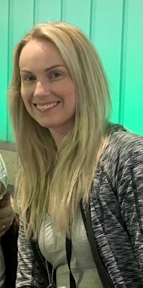
Photo © 2016 by Amy Hall.
Artsforum welcomes one such traveler to its pages as our latest roving correspondent. We’ll introduce Amy Hall to our pages in her own words:
“Amy Hall is a travel writer with a Master’s Degree in Art History from Queen’s University. Her favourite hobbies include shark diving, surfing, and devouring delicious food. Always on the move, she is happiest with salt in her hair and sand in her toes.”
Amy’s inaugural offerings take us to the South Pacific. ‘Salt in her hair and sand in her toes,’ indeed!
JA
**********************************
April 19, 2016
One Extreme to the Other
© By Amy Hall
After having spent an entire month living with eighteen other people
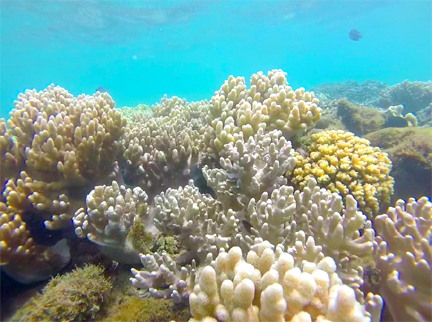
Corals at Rainbow Reef: Photo © 2016 by Amy Hall.
in very close quarters, I suddenly became the sole guest at Dolphin Bay Divers Resort on the northern island of Vanua Levu in Fiji. After my four weeks with the Shark Conservation Project, I planned to travel for two weeks on my own in order to see more of the country. Instead of the more popular group of islands to the west called the Yasawas, I decided to travel northeast of the main island to explore less travelled areas. I wanted to get off the beaten track, and that’s exactly what I did. Be careful what you wish for, I suppose!
The perk of being the only resident at the resort was that I was upgraded from the tent I had booked to a ‘bure’ – essentially a seaside hut with my own bathroom and real bed. Dolphin Bay is
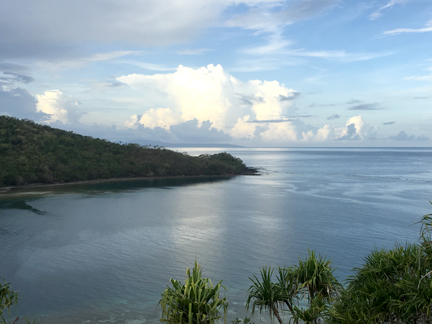
Dolphin Bay: Photo © 2016 by Amy Hall.
what I like to refer to as ‘glamping’ or glamorous camping. There is no road access or town, there is a generator that runs at set hours for electricity, there was no running water at the time I was there due to an unseasonal drought, and the furnishings are in line with what you would expect to find in a basic traditional cottage. What you can also find is complete and utter seclusion – waves on your doorstep that will quiet your mind and hush you to sleep at night, along with a kind of imposed relaxation.
Let’s be honest, most of us have a hard time sitting still for any significant period of time. We only slow down our busy lives when we are forced to, often times by illness. At first, upon my arrival, I resisted. I was bored and frustrated. Yet, the longer I was there, the more I could feel myself settle in. It was a perfect time to be reflective and let the crazy, hectic, amazing previous few weeks really sink in. When traveling, things fly by so fast they almost don’t feel real; so, it’s nice to have the opportunity to take a step back and appreciate it all.
Aside from the relaxation, the other reason people go to Dolphin Bay Divers Resort (as you can guess from the name) is the scuba diving. Its proximity to Rainbow Reef means that it is perfectly situated next to some of the most spectacular soft and hard corals in the world. On my dive excursions, it was only about a five minute boat ride to the dive sites, meaning we could even come back to the resort for surface intervals between dives – unheard of!
As a new diver, I used to think that a wetsuit was a good gauge with which to judge the quality of a dive shop’s gear. I quickly learned that this is not so. No one cares about wet suits. Of everything you will wear as a diver, this is one of the least important pieces of equipment. Yes, it will keep you comfortable and make the experience more enjoyable, but it is not what will be keeping you alive (at least in tropical climates!). Your buoyancy control device, regulators, and tanks are what matter – this is your lifeline. So, I was pleasantly surprised when one of the first things I saw upon my arrival was a rack of what appeared to be nearly brand new ‘Mares BCDs’ hanging out to dry. “I am in the right place,” I thought to myself as I arrived by boat. Getting into the water only further confirmed that conviction. I saw many of the ‘indicator species’ I leaned to identify during my time at the Shark Conservation Project, along with hundreds (if not thousands) of other species. The corals were breath taking and incredibly healthy – a small spot of hope for the future of our oceans. This is what it should be like.
Copyright © by Amy Hall.
**********************************
April 15, 2016
Shark Conservation in Fiji
© By Amy Hall
I briefly mentioned Projects Abroad and the Shark

Bull shark dive: Photo © 2016 by Amy Hall.
Conservation Project* while discussing how difficult it was to leave my new found home in Fiji behind. Some of you may be wondering just what exactly it was that I was doing during my time there. The best way to elaborate on what I was doing is to describe our weekly schedule:
Sunday – Dive Day!
Sundays and Wednesdays are the best days of the week. Why? Because they’re dive days! We’re assigned to either the morning or afternoon dives for the day. Morning dives are always the best because the wind usually picks up in the afternoon, thereby limiting the dive sites you can access and sometimes affecting the visibility. On the dives we are conducting surveys, looking for what are called
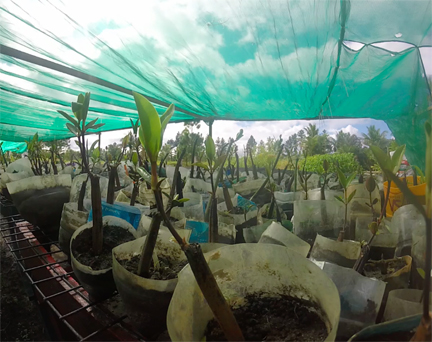
Mangrove nursery: Photo © 2016 by Amy Hall.
‘indicator species,’ specifically, the fish that sharks like to eat. Before you are able to participate in a proper survey dive, you must pass your fish ID test. In a nutshell, we swim around under water for 30 minutes writing down all of the indicator fish we see. This information is then recorded on the boat and entered into online databases.
Mangrove Monday
Or, as Kris, who is in charge of the mangrove nursery, would say, “Mangroves for Fiji baby!” Not only are mangroves a crucial link in a healthy marine ecosystem (75% of saltwater animals will call the roots of mangroves home at some point in their life), they are simultaneously one of the most efficient plants at converting carbon

Navua River: Photo © 2016 by Amy Hall.
dioxide into breathable air while providing protection from erosion and tsunamis. We had one of the largest mangrove nurseries in Fiji; so every Monday, we dedicated an entire day to maintenance, organization, planting ‘propagules’ (equivalent to seeds), and eventually planting the seedlings themselves in the rivers. It was often one of the more physically demanding days but also an incredibly rewarding one. Kris’ passion and excitement for the mangroves was infectious; it definitely rubbed off on everyone, myself included.
Tuesday – Chores
I always looked at Tuesdays as a very practical day. We would usually begin with a workshop or guest lecture, followed by house chores. In the afternoon, we would conduct surveys in one of the nearby towns to gather information about local fishing practices and public perceptions regarding sharks. Responses were very interesting because you would experience opposite ends of the spectrum: On the nearby island of Taveuni, locals worship a shark god and therefore have a great reverence for them. On the other hand, you might meet fishermen who think that sharks are ruining the fish population by eating their daily catch. You never knew what you were going to encounter. Our job was to collect information, not to preach or judge.
Mondays and Tuesdays were also tagging evenings. We would go out with the lead marine biologist, Gauthier, and tag any sharks we caught throughout the evening. Unfortunately, when I was there we were between projects. The previous work was done in the Rewa River with baby hammerheads; after a year of research, it is believed this may be one of the largest hammerhead nurseries in the world! When I went out in Navua, we were hoping to catch a few baby bull sharks, but, unfortunately, we didn’t have any luck. It was still a beautiful night out on the water in Fiji, though!
Wednesday – Dive Day!
One thing I forgot to mention about dive days is that we also drop a ‘BRUV’ before our survey dives. A BRUV is a ‘baited remote underwater video’ – a large contraption with a camera mount and bait. We would sink the BRUV and set the video to record for a few hours while we were gone on our dives. Watching the videos during land-based activities was either incredibly boring (as sometimes nothing interesting would come by) or incredibly exciting (you would hear people screaming when something like an eagle ray decided to check out the BRUV).
Thursday – Cultural & Community Days
Depending on the week, Thursdays were set aside for cultural days, community days, and/or land-based activities. Cultural days included things like making ‘tsulus’ (traditional Fijian sarongs for men and women), cooking ‘lovo’ (a traditional method of cooking in the ground with rocks), or learning the language. Community days during my time there consisted of helping to paint a local school and cleaning up the nearby beach.
Friday & Saturday – The Weekend
Since we dive on Sundays, Friday and Saturday became our weekend. Often times, we filled our weekends with, what else, more diving. A group of us went out on a tiger shark dive and ended up having a private dive with a 4-meter female, as we were the only divers there, aside from the staff. If you ever have the chance, you must dive in Beqa Lagoon: it’s one of the richest and most diverse ecosystems I have ever seen, and the project is working very hard to keep it that way.
Copyright © 2016 by Amy Hall.
* For information about Projects Abroad and the Shark Conservation Project, visit: http://www.projects-abroad.com.au/destinations/fiji/conservation-and-environment/shark-conservation/
**********************************
February 17, 2016
A Global Community: Friendships While Travelling
© By Amy Hall
I thought that a whole month in one location in Fiji would feel like a

Dive with Oscar: Photo © 2016 by Amy Hall.
long time. Maybe even an eternity, considering that I would be sharing a room with up to three other people. Yet, as I sit here writing this approaching the end of my time with Projects Abroad, I feel like I just arrived yesterday. Like I’m running out of time. Like I don’t want to leave.
To be honest, I didn’t expect to be feeling like this. I thought adjusting to things would be a bit of a struggle – not an insurmountable one, but a struggle nonetheless: From the heat, to being around a group of people all the time, to likely being the oldest, to not being able to cook my own food. I’ve lived by myself for the last five years, so I thought this would be the most difficult part; but, as it turns out, the things that were of greatest concern to me are

Shark Reef Marine Reserve dive with Noah: Photo © 2016 by Amy Hall.
actually what I am going to miss the most. I have grown accustomed to spending 24 hours a day, seven days a week with this group of people, and it is going to feel incredibly strange to not be around them anymore, to be back on my own.
It amazes me how quickly and deeply you can form friendships when you travel. Why that happens, I’m not exactly sure. I suppose it’s a combination of things. Everyone is out of their comfort zone, meaning that generally people are more open and understanding. You also share experiences together that are so unique it creates lasting memories – memories and experiences which are sometimes difficult to properly communicate to friends back home. Most importantly, though, I’ve found that what makes being here different from anywhere else I’ve travelled is that we are all focused on the goals of the shark conservation program: We have the same interests and values, and are working together to do something we believe in. The work here is not always easy; it’s not just diving and sitting by the beach. Two weeks ago we helped to paint a local school in the midday heat, and this week I was shovelling topsoil in 32 degree weather so we could repopulate the mangrove nursery. All of these are integral parts of the project. And when you see your friends not only carrying their weight, but working their asses off, it motivates you to do the same: You develop a respect for them that makes you start to feel like a family.
That’s what’s different: I’ve just begun to feel like part of a small family here, and now I am leaving. Some I’ve known just for a few short days and others my entire time here. We are an eclectic group from all over the world, which is part of what makes saying goodbye so hard – I don’t know when I’m going to see them again. We’re Canadian, American, German, Norwegian, Swiss, Australian, Swedish, Indonesian, Dutch, and South African. I know that things just won’t be the same without them. I left my small town in hopes of finding a vibrant, thriving, like-minded community. I suppose I never expected to find it so quickly, with a melting pot of nationalities halfway across the world.
Copyright © 2016 by Amy Hall.
**********************************
January 20, 2016
How to Kill Eight Hours in LAX
© By Amy Hall
Los Angeles International airport is one of the busiest in the world.

Yoga at LAX: Photo © 2016 by Amy Hall.
As a state of the art facility, there is no shortage of provisions for entertainment. After passing through the golden gates of security, you are welcomed into consumer heaven. It’s easy to kill a few hours, if you are also looking to drop several thousand dollars – you can shop at stores like Burberry, Gucci, and Tom Ford; ship champagne and caviar at Petrossian; or swing by the duty free, if you’re in the mood, to pick up a $4,000 bottle of scotch. Some of the world’s most rich and famous call L.A. home, so the sumptuousness should come as no surprise; but, what are the rest of us supposed to do?
Not to worry, there are still of lots of things to keep us common folk sufficiently entertained. Here are a few suggestions after my own eight hour stint in LAX.
(1) Nap: The tried and true airport ‘go-to’ of backpackers and business travellers alike. We all know there’s no easier or more efficient way to kill an hour or two than to find a comfy spot and catch a few z’s. Finding a comfortable location can sometimes require a little creativity. Long benches are a god-send, and my heart breaks a little every time I stroll by and see them divided with individual armrests. For those of you daring (or desperate) enough, there’s always the floor – with your carry-on for a pillow. I’m happy to say that none of the above are necessary in L.A.: they have beautiful lounges equipped with comfortable chairs, tables, benches, and lamps. So, pull up a seat, set an alarm (you don’t want to miss your boarding call!), and take a nap. Not only is it free, it will help you feel a little more rested before the next leg of your journey.
(2) Exercise: Once you are rested, why not get your blood flowing
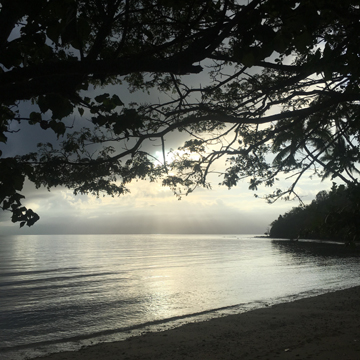
A dream of things still to come (beach at dusk): Photo © 2016 by Amy Hall.
to your extremities with a little exercise? (You may feel you’ve gotten your fair share of physical exertion while carting your 50 pound luggage across miles of airport terminals. If that’s the case, feel free to skip to number 3.) There are lots of free, bodyweight exercise routines available online; but I wouldn’t recommend anything too intense, just enough to get your heart pumping and oxygen flowing. For long-haul flights, I generally am wearing workout tights and runners. If you’re dressed in more restricting attire, consider packing an outfit change in your carry-on.
(3) Yoga: Before setting foot onto another 12-hour flight, let’s get your body back in alignment. For hundreds of years, yoga has been practiced to properly stack bones and muscles in preparation for meditation. If it can work for monks, before hours of sitting on the floor without moving an inch, it can work for you. You can find millions of free videos online to stream to your computer or phone. If you’re a newbie, watching the video may be best, so you can see visual cues. If you have tried yoga before, you prefer to play the video on your phone, plug in your headphones, and tuck it into a pocket, so you can let the instructor’s voice guide you. LAX has free wi-fi (hallelujah!), so you can easily search for bodyweight exercises and yoga lessons that are suitable for you. The biggest hurdle will likely be getting over feeling silly doing this in front of other people; but take a word of advice – no one cares what you do at an airport: It’s like an otherworldly dimension, so go ahead and do your thing.
(4) Coffee and Cookies: Caviar and champagne not in the budget? How about just sticking to good ol’ tea or coffee and baked goods. You’ll get a nice caffeine boost, and let’s be honest, you deserve that treat – travelling can be stressful, after all. Get a spot right by the window, and watch the planes land, or open up a newspaper or magazine. I got a free magazine, with the purchase of some snacks from a little general store, and, ironically, it was all about Toronto.
(5) Make New Friends: When all else fails, make new friends. Aside from napping, this is the easiest and most entertaining way to pass the time. People are always more open and friendly when they are on the move. I often give my mom a hard time about striking up conversations with random people; but sometimes it is actually quite interesting: She’ll go to buy a water bottle during a layover in Germany and find out that the cashier has a niece who lives up the road from the family cottage back home. I became fast friends with a lovely couple, Tim and Nancy, when we were getting off the plane at LAX and realized that we were on the same connecting flight. Since our boarding passes weren’t printed in Toronto, we had to check-in at the counter, which, of course, didn’t open for several more hours… So, we went on an adventure to find a little bar.
There are many other things to do, of course (like window shopping or card games), but the point is to prepare yourself mentally and physically for another long flight.
Copyright © 2016 by Amy Hall.
*****************************************
